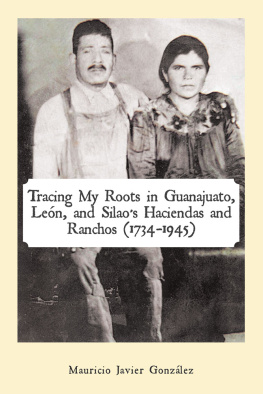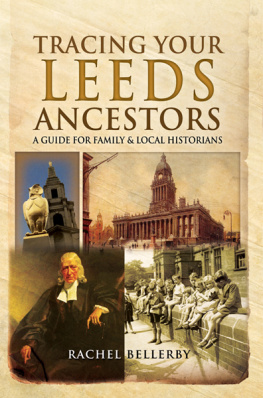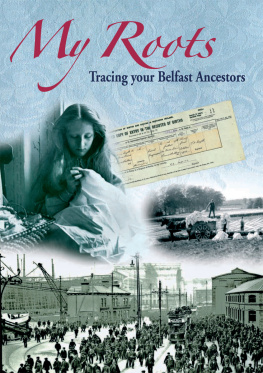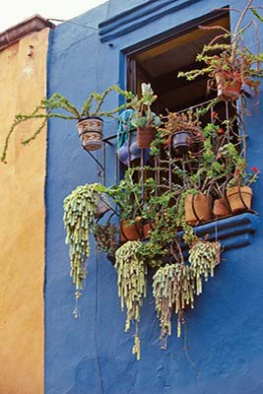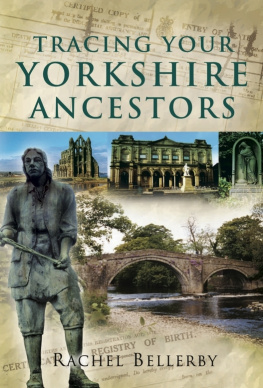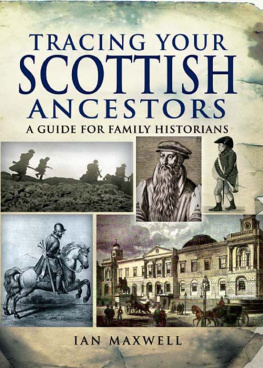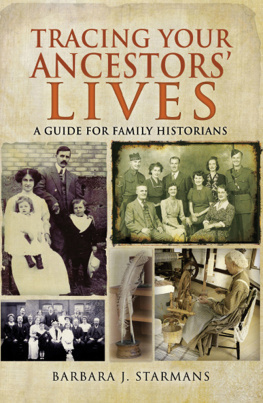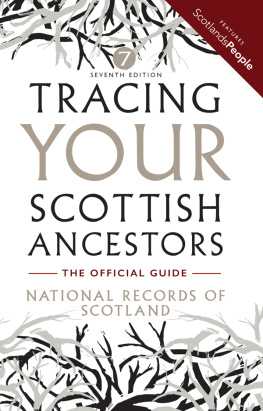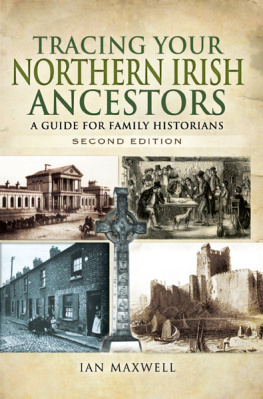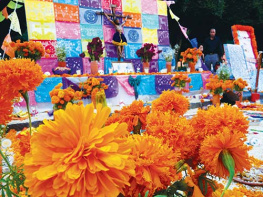Tracing My Roots in Guanajuato, Len, and Silaos Haciendas and Ranchos ( 17341945 )
MAURICIO JAVIER GONZLEZ
Copyright 2017 by Mauricio Javier Gonzlez.
Book cover image: Andrs Gonzlez and Tomasa Daz, Silao, Guanajuato, early 1930s
Library of Congress Control Number: 2017901653
ISBN: Hardcover 978-1-5065-1887-9
Softcover 978-1-5065-1886-2
eBook 978-1-5065-1885-5
All rights reserved. No part of this book may be reproduced or transmitted in any form or by any means, electronic or mechanical, including photocopying, recording, or by any information storage and retrieval system, without permission in writing from the copyright owner.
The views expressed in this work are solely those of the author and do not necessarily reflect the views of the publisher, and the publisher hereby disclaims any responsibility for them.
Any people depicted in stock imagery provided by Thinkstock are models, and such images are being used for illustrative purposes only.
Certain stock imagery Thinkstock.
Rev. date: 25/03/2017
Palibrio
1663 Liberty Drive
Suite 200
Bloomington, IN 47403
CONTENTS
The Places and History Surrounding
The Lives of My Ancestors in Guanajuato
18.Saldaa and Salinas Family Members
(Mentioned in the book)
To the memory of my grandmother Tomasa Daz and my father, Narciso Gonzlez
For her resilience and decision to make a home in La Frontera, where my father married my mother in 1960
For his big heart filled with humility and kindness
Enchanting Words
by Mauricio Javier Gonzlez
In honor of my father and grandfather, Narciso and Andrs Gonzlez
The children, barefooted and with gleaming little faces,
gathered excitedly around their father under the crummy wooden porch.
The youngest found his lap taken and sat on the ground,
his scraped legs crossed Indian style.
With heads tilted upward and one hand under their chins,
they listened to the man whose enchanting words
did not match his ragged shirt and overalls.
Yet, the children listened like members of congress
listen to a president or parliament to a prime minister.
Only here, afterwards, the children hugged, kissed,
and climbed all over the speaker.
T he study of my fathers ancestry has four main parts. Part I consists of narratives and essays that relate the events that transpired as I researched my dads roots. They trace my steps from the time I first got the idea to take on this project. They also describe my use of microfilm to research church records without having to set foot in far-away churches. They recount my travels to Guanajuato throughout the 1990s and early 2000s. Finally, they explain how I resumed my research after relegating it for many years.
Part II includes a synopsis of the places and history surrounding the lives of my ancestors in Guanajuato. It is meant to give the reader background information to understand how the lives of my ancestors unfolded during different eras and locations. My grandparents genealogies follow this brief history. Each ancestry begins with them and reaches as far back as the early and late 1700s, respectively. They traverse and branch out over several jurisdictions Guanajuato, Len, and Silao.
Part III is a series of photographs and facsimiles that enhances the books content and promotes its authenticity. Most of the pictures are of me on my different trips to Guanajuato. A few are pictures from the past. They include a portrait of my paternal great-grandfather, Lucas Gonzlez.
Part IV is made up of appendices, mainly family tree fan charts, that help the reader navigate the parade of names that make up the genealogies in Part II. It also includes numerous tables, which serve as visual aids.
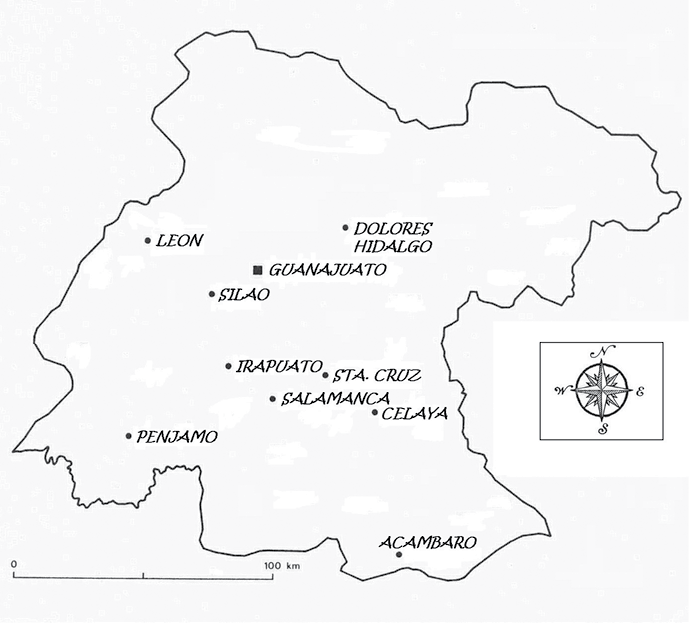
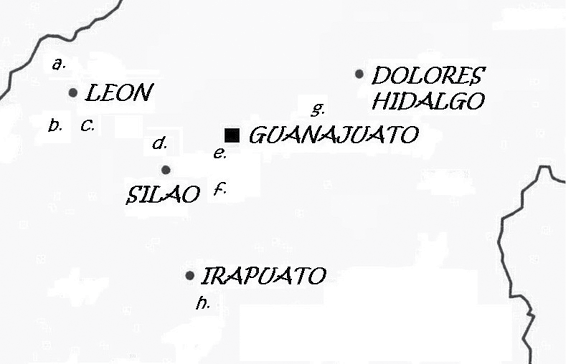
Map of Guanajuato with Legend
The letters on the map stand for the general location of the places listed below.
LEON
a.)
Hacienda El Palote
Hacienda Lagunillas
b.)
Hacienda San Judas (San Pedro del Monte)
Hacienda Santa Rosa
c.)
El Monte (Tepetates)
SILAO
d.)
El Coecillo (Hacienda)
San Agustn (Hacienda)
GUANAJUATO
e.)
Marfil
f.)
Caada de Bustos
El Capuln
Hacienda de Cuevas
DOLORES HIDALGO
g.)
Cruz de Piedra
IRAPUATO
h.)
Hacienda San Roque
PART I
Narratives and Essays
T he idea to write a book about my fathers family history first came to me in 1988. However, as I began to do research, I soon discovered that investigating my mothers side of the household was more feasible. For one thing, there were already well-established genealogical organizations dedicated to the study of the history and ancestries of families from northeastern Mexico (Coahuila, Nuevo Len, and Tamaulipas) and South Texas. My mothers ancestors, who arrived in South Texas from northeastern Mexico as early as 1750, fit perfectly within the scope of research done by many genealogical societies. These included Los Bexareos Genealogical and Historical Society (San Antonio), The Spanish American Genealogical Association (Corpus Christi), Las Porciones Society (McAllen), and The Hispanic Genealogical Society of Houston. Thus, the supply and demand for such historical and genealogical studies put the necessary information at my fingertips. And although the genealogical groups findings did not represent my entire sources, they did catapult my research and writing projects. As a consequence, I wrote and privately published three books Un encuentro con el pasado en San Ygnacio, Texas (Border Studies, 1994), The Herreras of San Ygnacio, Texas (Border Studies, 1998), and My Grandfathers Grandfather: Toms Rodrguez Benavides (Nuevo Santander Press, 2002).
Unfortunately, I did not find the same supply and demand phenomenon when it came to the history and genealogy of families of North-Central Mexico. Despite this setback, I remained curious and still wanted to investigate my fathers roots. Without the aid of historical and genealogical societies like the ones mentioned here, I knew the task would be monumental. I reminded myself that I pretty much would have to start from scratch just as members of The Bexareos and other groups did beginning around 1981. And so just like these committed researchers, I sought the original sources, church records, in my case, of the state of Guanajuato. Luckily, The Church of Latter-day Saints (The Mormon Church) had already taken on the massive task of photographing church records from across the world, including Mexico. Also, they had made them accessible to the public in microfilm form. As a result, throughout the 1990s I traveled to the family history center in McAllen to view many rolls of microfilm. At the time, Laredo did not have such a facility.
After ordering and scrutinizing many reels of microfilm, I gleaned the necessary information to build strong family trees for both my parents. Nevertheless, with the investigations and publications put forth by the historical and genealogical associations, my mothers research soon surpassed my fathers. What is more, as I attended several of the annual conferences hosted by the different genealogical societies (the first meeting I attended was in 1991; Las Porciones Genealogical Society of McAllen, Texas hosted it), I found myself eager to publish and share my findings. Since my mothers family history had reached different levels of completion, and most importantly, represented the societies targeted regions for research and expos, I concentrated my efforts on her side of the family. Not thinking I would relegate my fathers study for too long, I put half of my notes in boxes and got busy writing books about my mothers ancestors.
Next page
